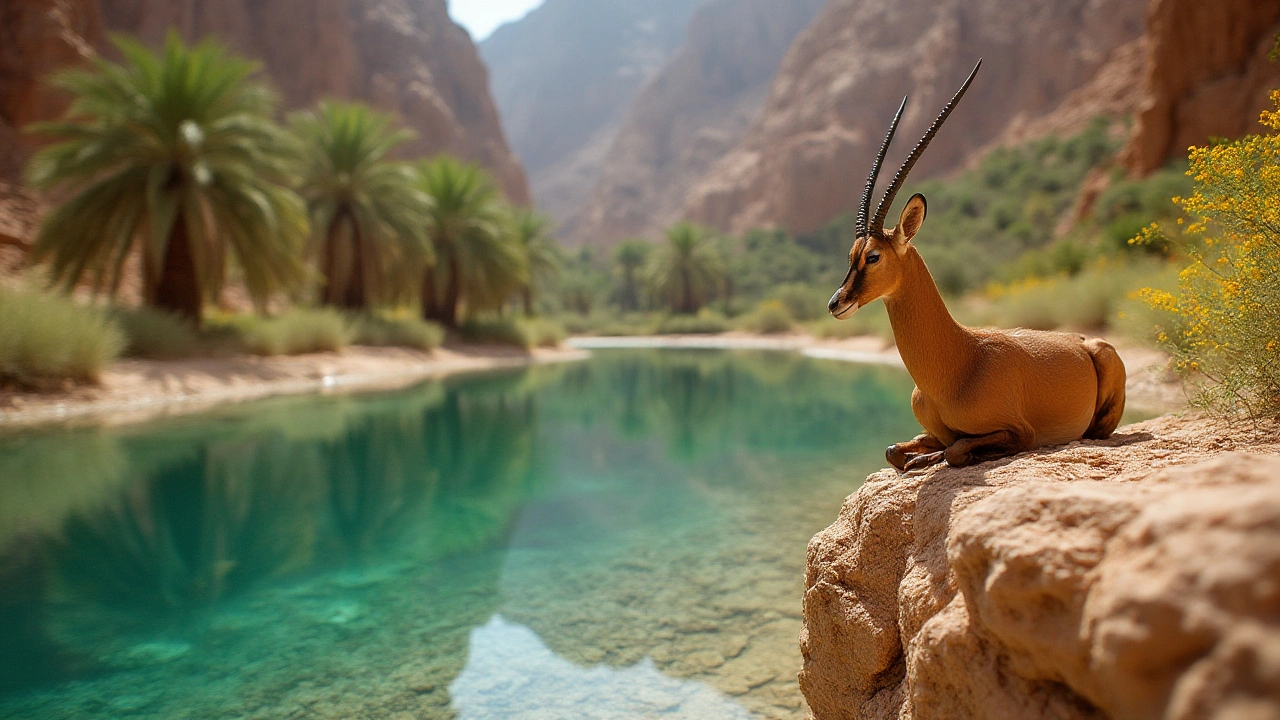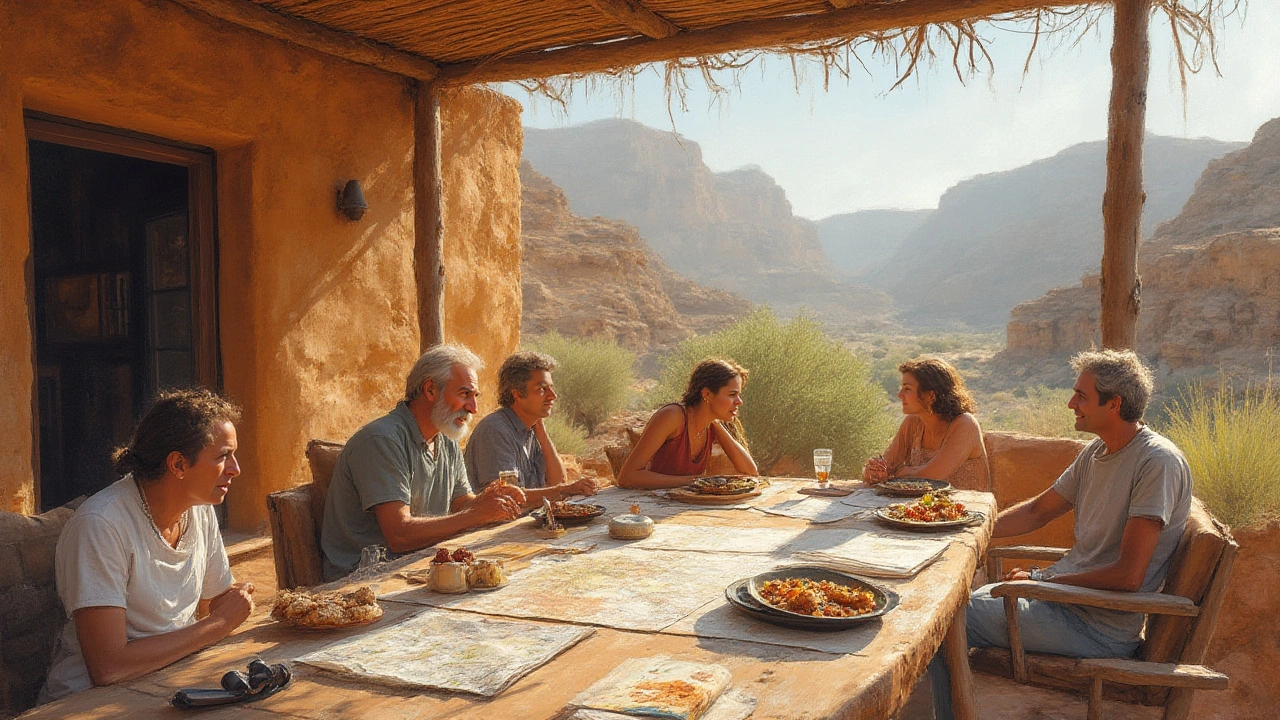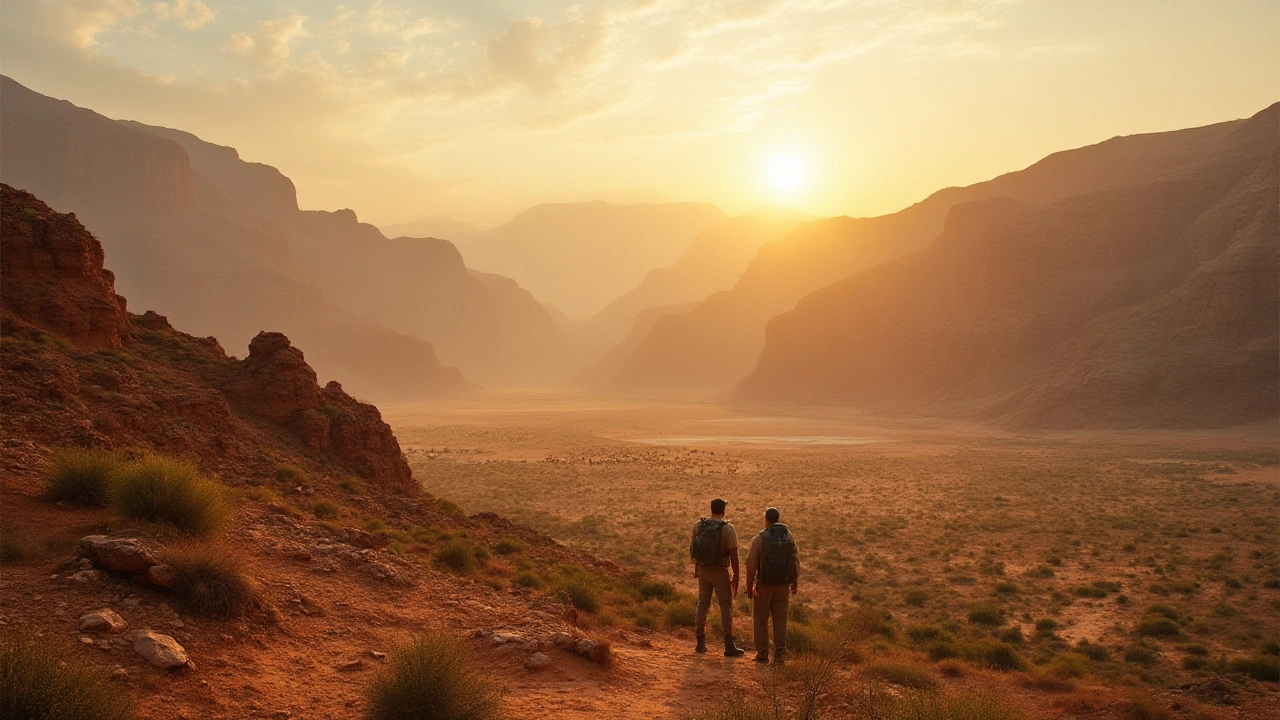There’s a stretch of Israel where the sun seems stronger, the sky feels wilder, and silence settles like a warm blanket. It’s not the Dead Sea most tourists talk about, nor is it Eilat’s flashy beaches. This place is the Arava: a long, narrow valley carving its way between the Dead Sea and the Red Sea, bordered by Jordan to the east and the Negev’s sandstone cliffs to the west. It’s one of those rare spots that seem to exist in another world, where the usual rules of green landscapes and wet weather simply don’t apply. But is it just dry rocks and sand? Not even close. The Arava is full of surprises if you look a bit closer.
The Unique Environment and Climate of the Arava
Ask anyone who’s driven Highway 90 south of the Dead Sea, and they’ll mention the endless sun, the shimmering mirages, and dust devils spinning across an empty landscape. At first glance, the Arava screams desert – and it is. Rain barely visits, sometimes skipping whole seasons, and summer temperatures regularly soar above 45°C (113°F). Yet, it’s never only about heat and sand. Here’s where it gets interesting. Even though the Arava receives less than 50 millimeters of rain a year, it hosts a wild variety of life and is much greener than you’d expect. Water trickles underground in ancient aquifers, feeding salty springs and stubborn trees. A quick look at a map might show a blank space, but on the ground, ecosystems hustle for survival. Tamarisk trees shake off dust near dry riverbeds, acacia groves host secretive foxes, and rare wildflowers bloom for a single day after a brief winter shower.
Another fun fact: the valley floor sits below sea level around the Dead Sea, but steadily rises to 200 meters above sea level as you head south. That drop shapes weather patterns, funneling hot winds and sometimes trapping chill winter air. Dust storms appear out of nowhere, dropping visibility to near zero. If you spend the night, prepare to stargaze – the skies here are famously clear. The lack of city lights brings out the Milky Way so sharply it looks painted on. There’s even a science station, the Arava Institute, that tracks every subtle climate change, keeping a curious eye on how climate change might push this ecosystem to its limits.
Life Finds a Way: Nature and Wildlife of the Arava
It’s easy to assume deserts are empty, but the Arava proves you wrong at every turn. One early morning, you’ll see ibex scrambling up dry canyons or maybe catch a glimpse of a desert fox vanishing into the brush. This area is a crossroads for African, Asian, and European species, which makes its wildlife odd – in the best way. Take birds: every spring and fall, the valley turns into one of the world’s largest migration highways. Over 500 million birds pass through, including storks, eagles, and brightly colored bee-eaters, all pausing at the few reliable water holes on their journey between continents.
On the ground, things get even weirder. Camels and Nubian ibex compete for shade with leopard geckos and echis snakes hidden under salty stones. The Arava is home to 39 types of mammals and more than 100 species of butterflies. If you’re lucky, you might spot the Arabian wolf or, rarely, striped hyenas. There’s also a unique breed of wild date palm found only in the springs near Ein Yahav. Oh, and watch out for insects: a single square kilometer of Arava soil can host up to half a million ant colonies. If you’re an arachnophobe, maybe just stick to the main road.
If you want to explore nature, local reserves like Hai-Bar Yotvata let you get close (but not too close!) to rehabbed endangered animals. Wild asses, sand cats, and griffon vultures all get a second chance there.

Human History and Ancient Secrets Beneath the Sand
Don’t let the untouched look fool you – people have made lives here for millennia. Dig a bit and you’ll turn up copper mines dating back to the days of Pharaohs, and the remains of Roman garrisons who guarded trade routes across this “wasteland.” Ancient Jewish, Nabatean, and even Byzantine communities left their marks, scratching vineyards and villages out of the crudest ground. Excavations near Timna Park uncovered 3,000-year-old mining camps believed to supply copper to King Solomon. Scrolls hidden in Arava caves once sheltered rebels during Rome’s crackdown on Jewish uprisings. In short, this area saw as much history as any lush northern valley – the remains just hide better.
Modern pioneers, too, keep the legacy alive. For decades, kibbutzim and moshavim (communal farms) fought the climate with solar-powered greenhouses and drip irrigation. The Arava’s tomatoes and peppers, grown hydroponically, regularly win Israeli taste tests, and the date orchards thrive on barely any water. The area even leads Israel in solar energy production, with vast photovoltaic fields soaking up the crushing sunlight. In fact, 70% of the Arava’s energy demand is now met by solar panels, an incredible stat for such a rural spot.
Still, the struggle continues: farmers keep tweaking tech and fighting off salt, while archeologists dig for lost secrets. Ghost villages and ancient watering holes dot the land, waiting for the next curious visitor to stumble across a pottery shard or lost coin stamped with a desert king’s face.
Traveling the Arava: What To See and How To Survive
You’re not going to find Vegas lights or fancy five-star resorts here – and that’s honestly half the point. The Arava is best explored by slowing down. The main highway runs straight and true for nearly 180 kilometers, with gas stations, roadside lemonade stands, and roadside motels that offer a soft bed and thick blackout curtains. Think of it as pure road-trip country: every few kilometers, a turnoff offers something strange or beautiful.
- Timna Park: Ancient copper mines, dramatic red cliffs, and wacky rock formations like the Mushroom and Solomon’s Pillars. Guided tours and cycling trails make it easy for everyone, even if you’re not Indiana Jones.
- Yotvata Dairy Kibbutz: Famous for chocolate milk (the best in Israel, no contest) and kid-friendly petting zoos. Don’t skip the ice cream.
- Hai-Bar Yotvata Reserve: As mentioned earlier, your best bet to snap photos of the rarest desert wildlife.
- Lotan Ecological Kibbutz: Learn about sustainable building and organic farming, or try a composting toilet (if you’re brave enough).
- Ein Yahav: Not a single massive resort, but scattered B&Bs and farm cabins where you can sip sweet date wine and stargaze from a hammock.
If you’re hiking, always check weather forecasts; flash floods can turn dry canyons deadly in minutes. Bring at least twice the water you think you’ll need (seriously, don’t risk it), sun protection, and a map in case your GPS goes weird when cell service drops out. Watch kids and pets around wildlife, and don’t pick flowers – some are protected and vanish quickly.
Daredevils sometimes book desert jeep tours or camel rides, and cyclists tackle the Arava’s long, straight bike paths between kibbutzim. Once a year, the Arava Open Valley Festival draws musicians, food trucks, and craft brewers for a long weekend of stargazing and bonfires. If you want a calendar event, that’s it – music echoing across raw desert nights is something you remember forever.

Tips for an Unforgettable Arava Adventure
Okay, so you’re set for the trip, but want more than the usual tourist stop. Here’s what locals (and returning adventurers) swear by:
- Best time to visit? November to March, when the daytime heat backs off but nights stay mild. April and May explode with migrating birds if you’re a birder.
- If you have time, cross into Jordan at the Arava border and visit Wadi Rum. The landscape on both sides is stunning, and the border process is usually simple with the right paperwork.
- Try desert farming workshops to learn how real food gets grown against the odds. The Arava R&D Center in Sapir holds half-day classes open to everyone (kids go wild for the tomato tastings).
- Use the open-air hammocks and pools dotted across the kibbutzim. Nothing beats floating under the harsh sun with good tunes and cold lemonade.
- Carry cash: many side-of-the-road produce stands and local eateries don’t accept cards. This isn’t Tel Aviv – WiFi is not a given.
Still worried about melting in the heat? Treat yourself to eco-lodges with shaded decks, or plan afternoon siestas. The rhythm of life here bends to the sun. If you’re after souvenirs, skip the keychains and bring home organic dates or bottles of artisan Arava olive oil, pressed on local farms. And before you leave, look up. Some nights, the desert is so quiet you can hear the hum of the stars – it’s the kind of stillness that doesn’t exist anywhere else in Israel.
| Fact | Details |
|---|---|
| Annual Rainfall | Less than 50 mm |
| Length of Arava Valley | 180 km |
| Mammal Species | 39 |
| Types of Birds Seen Annually | Over 500 species |
| Solar Energy Share | 70% of local demand |
So, is Arava just a desert? Hardly. It’s a living, changing, sometimes unimaginably tough valley that holds more life, more history, and more possibility than the dusty first impression ever lets on. Whether you want adventure, peace, weird wildlife, or a taste of life at the frontier of science and survival, the Arava says: slow down and stay a while – the magic takes a minute to notice.



 Medications
Medications





Alan Whittaker
July 10, 2025 AT 00:54Honestly, there’s probably more going on beneath the surface in the Arava than meets the eye. I mean, it’s a hotspot for “rare” wildlife and “unique” landscapes, but who’s really monitoring that? There’s always some level of ecological manipulation or government interference in these so-called pristine areas.
Plus, the mention of insider travel tips makes me question the accessibility and commercialization of the place. Are these tips sanctioned by tourism boards, or are they actually a cover-up for controlling the narrative on how the valley is consumed by outsiders?
One has to wonder if the ‘hidden wonders’ are just marketing jargon intended to lure a certain type of traveler, while the ecological reality is far less enchanting. And considering Israel’s geopolitical state, I wouldn’t be surprised if there’s some strategic importance behind the Arava’s promotion.
Michael Waddington
July 11, 2025 AT 05:14Man, I reckon you’re overthinking it a bit. The Arava valley seems like a pretty legit spot to explore, with heaps of cool wildlife and landscapes that you probably won't find anywhere else.
Everyone’s got some conspiracy theory nowadays, but sometimes it’s just about appreciating nature and the local vibe without trying to read too much into it. Insider tips are just practical advice from locals or seasoned travelers – nothing sneaky.
Honestly, mate, if you're looking for a good adventure, this sounds like a winner. Desert valleys aren’t just about sand and rocks; they pack heaps of life and stories.
HAMZA JAAN
July 12, 2025 AT 09:34Wait, wait, wait. Are we seriously talking about the 'magical desert valley' like it’s some untouched fantasy land? Like, come on, these places always have some drama going on, whether it’s environmental stress, local disputes, or just tourists trashing the place.
What’s the real story here? Has anyone gone deep into the Arava and found out what’s actually hidden? Not those polished ‘travel tips’ but the raw, gritty truth. This smells like another spot getting hyped up to distract from urban chaos or real global issues.
Also, anyone else thinking about what kind of wildlife is “rare”? Is it protected properly or just a talking point to get clicks?
April Rios
July 12, 2025 AT 23:44Exploring the Arava isn’t just about uncovering natural beauty; it’s about understanding our place within this vast and ancient landscape. When we talk about wildlife and landscapes, we tap into a deep interconnectedness that reminds us of our responsibility to preserve these environments.
To truly appreciate the Arava’s wonders, one must see beyond the mere surface. The way ecosystems survive harsh desert conditions offers profound lessons on resilience and adaptability — qualities we should admire and emulate.
Insider travel tips are more than practical guides; they’re invitations to engage respectfully with the land and its stories, to tread lightly and acknowledge the fragile balance between humanity and nature.
byron thierry
July 15, 2025 AT 08:08As someone who has spent considerable time in various cultural landscapes, I can say the Arava stands out as a truly unique ecological and historical enclave. It’s not simply a desert valley; it’s a crucible where nature and civilization have quietly interwoven for millennia.
The rare species and striking geography serve as a reminder of how diverse and fragile our world is. It is crucial we approach such places with a mix of admiration and scholarly respect.
Recommendations for travel must be tempered by an awareness of local customs and ecological sensitivities. Sustainable tourism here is key to preserving the beauty so eagerly sought by adventurers worldwide.
M Black
July 17, 2025 AT 15:24Wow, this looks incredible!!! I’ve always wanted to visit the desert but never found a spot that sounds this exciting. Thanks for sharing such cool info about the Arava 😄
Does anyone know when’s the best time to go? I bet sunrise or sunset must be absolutely breathtaking there! Also, are there any guided tours or just self-exploration stuff?
Super pumped to add this to my travel bucket list — nothing beats discovering hidden jewels like this!! 😀
Sidney Wachira
July 24, 2025 AT 14:21I swear, every time someone says 'hidden wonders', I get a little skeptical but also curious. Like, what exactly are these wonders? Are we talking secret caves, ancient ruins, or just amazing sunsets over endless sand?
Also, how tough is it to trek through the Arava? I wanna know if it’s beginner-friendly or a hardcore adventure for the brave. And please, someone drop some pics or stories if you’ve been; I’m living vicariously through y’all right now!!! 🌵🔥
Plus, if anyone finds out about the rare wildlife, spill the beans! I wanna know if there’s cool critters or not.
Aditya Satria
July 27, 2025 AT 23:28The Arava Valley’s ecological significance cannot be overstated. Hosting a remarkable array of biota in such a harsh climate is a testament to nature’s adaptability.
Beyond the aesthetics, we should emphasize conservation efforts and how travelers can minimize their impact. The insider travel tips mentioned should ideally include guidance on respecting wildlife habitats and supporting local communities.
Embracing an open-minded approach not only enriches the experience but honors the delicate balance that sustains this desert valley.
Jocelyn Hansen
August 2, 2025 AT 05:01This post got me so hyped about deserts again! The Arava sounds like a dream destination — all those unique landscapes and that rare wildlife? It’s like nature’s best kept secret.
Would love to know more about the insider travel tips though! Are there local guides who make sure visitors get the most out of their trip? And what about safety precautions? Deserts can be tricky for first-timers.
Plus, anyone who’s been, shout out your most unforgettable moment! Sharing experiences like this makes me wanna pack my bags asap! 😊🌞